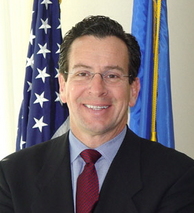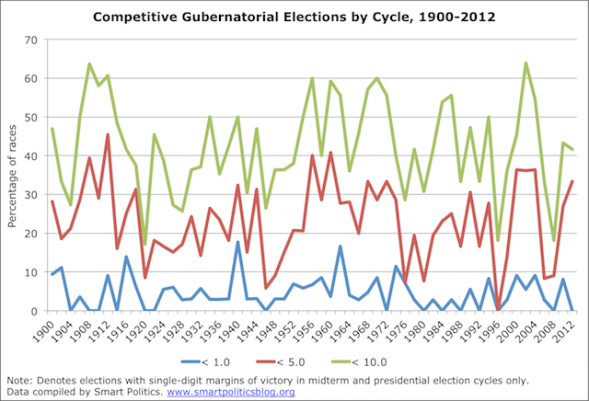No Wiggle Room: The 2014 Gubernatorial Elections Are Lousy with Toss-ups
The eight tightest gubernatorial races in the country all involve incumbents and the 2014 cycle could yield the most gubernatorial races decided by less than a point since at least 1900

That’s nearly one-third of the 36 states that hold gubernatorial elections this cycle.
Survey data seems to bear out Christie’s claim at this time, with the polling average of 10 states currently coming in with a spread of less than five percentage points and eight states at less than two points.
Through mid-day Sunday, the average polling spread for each of the 36 races at Real Clear Politics (RCP) revealed:
● Five contests within less than one point: Colorado, Connecticut, Illinois, Kansas, Wisconsin
● Five between 1.0 and 4.9 points: Alaska, Florida, Georgia, Maine, Massachusetts
● Seven between 5.0 and 9.9 points: Arizona, Arkansas, Hawaii, Michigan, Minnesota, New Hampshire, Rhode Island
● Nineteen at more than 10.0 points: Alabama, California, Idaho, Iowa, Maryland, Nebraska, Nevada, New Mexico, New York, Ohio, Oklahoma, Oregon, Pennsylvania, South Carolina, South Dakota, Tennessee, Texas, Vermont, Wyoming
What’s remarkable about the 2014 cycle – should the polling averages hold – is the unusually large number of races this cycle with razor-thin polling ‘advantages’ of just fractions of a percentage point.
Real Clear Politics averages find:
● Democratic Governor John Hickenlooper of Colorado up 0.8 points over challenger Bob Beauprez
● Democratic Governor Dan Malloy of Connecticut (pictured at top) trailing GOPer Tom Foley by 0.3 points in a rematch of a 2010 race decided by 0.6 points
● Democratic Governor Pat Quinn of Illinois down 0.2 points to Republican Bruce Rauner
● Republican Governor Sam Brownback of Kansas tied with Democrat Paul Davis
● Republican Governor Scott Walker of Wisconsin tied with Democrat Mary Burke
Add to that narrow spreads in three other races at just around 1 percentage point:
● Republican Governor Rick Scott of Florida trails Democrat Charlie Crist by 1.0 point
● Republican Nathan Deal of Georgia is up 1.3 points over Democrat Jason Carter
● Republican Paul LePage of Maine is up 1.8 points over Democratic Congressman Mike Michaud
In short, each of the eight tightest gubernatorial races in the country according to RCP polling averages all involve incumbents.
What’s more, if most of these races continue to go down to the wire, the 2014 cycle might just set a modern record for the most races decided by a fraction of a percentage point.
Smart Politics examined the more than 1,600 gubernatorial elections conducted during midterm and presidential election cycles since 1900 and found that only three cycles have produced as many as five contests with a victory margin of less than one percentage point.
There are at least eight in the mix to do so in 2014.
Across the 57 election cycles since 1900, two have yielded six gubernatorial races decided by less than a point – 1940 and 1962.
In 1940, the country saw down-to-the-wire races in six of 34 contests, or 17.6 percent: in Indiana (0.2 points), Kansas (0.1), Massachusetts (0.3), Missouri (0.2), Washington (0.8), and Wisconsin (0.9).
Republicans won five of these six races – only falling short in the open seat Hoosier State race.
In 1962, six of 36 gubernatorial contests saw victory margins of less than a point, or 16.7 percent: with Democrats winning in Massachusetts (0.2 points), Minnesota (0.0), North Dakota (0.9), and Wisconsin (0.9) and the GOP winning Maine (0.2) and Rhode Island (0.1).
In 1916 five of 36 races yielded a victory margin of less than one point:Arizona (0.1 point), Idaho (0.4), Missouri (0.3), Ohio (0.6), and West Virginia (0.9).
The only other cycles since the 20th Century in which at least 10 percent of gubernatorial races were won by less than a point were in 1902 (3 of 27, 11.1 percent) and 1974 (4 of 35, 11.4 percent).
Overall, just 82 of the 1,661 gubernatorial races held during midterm and presidential election cycles since 1900 have been decided by less than a point, or 4.9 percent.
Another 306 contests were decided between 1.0 and 4.9 points (18.3 percent) and 326 others by between 5.0 and 9.9 points (19.6 percent).
In other words, a larger percentage of gubernatorial races in midterm and presidential election cycles have been decided by less than five points (23.4 percent) than between 5.0 and 9.9 points (19.6 percent).
The cycle with the largest percentage of elections for governor decided by less than five points since 1900 came in 1912 with 15 of 33 (45.5 percent).
Rounding out the Top 5 are 1960 (40.7 percent, 11 of 27), 1956 (40.0 percent, 12 of 30), 1908 (39.4 percent, 13 of 33), and 2000 (36.4 percent, 4 of 11) and 2004 (36.4 percent, 4 of 11).
The cycles with the largest percentage of races with victory margins of less than 10 points since 1900 are 2002 (63.9 percent, 23 of 36), 1908 (63.6 percent, 21 of 33), 1912 (60.6 percent, 20 of 33), 1956 (60.0 percent, 18 of 30) and 1970 (60.0 percent, 21 of 35).
In addition to the eight governors in dead heat elections mentioned above, incumbents in Alaska (Republican Sean Parnell) and Pennsylvania (Republican Tom Corbett) are trailing in RCP averages to independent Bill Walker and Tom Wolf by 3.8 and 11.0 points respectively.
Over the last 50 years, 304 governors have won reelection while another 102 lost their party’s nomination, lost a general election, or lost a recall election, for a reelection rate of 74.9 percent during this half-century span.
Follow Smart Politics on Twitter.


While generally true, some polls used to calculate the rcp average are outliers especially in Kansas and Maine. The only incumbent that is likely to be unseated is Corbett in PA.